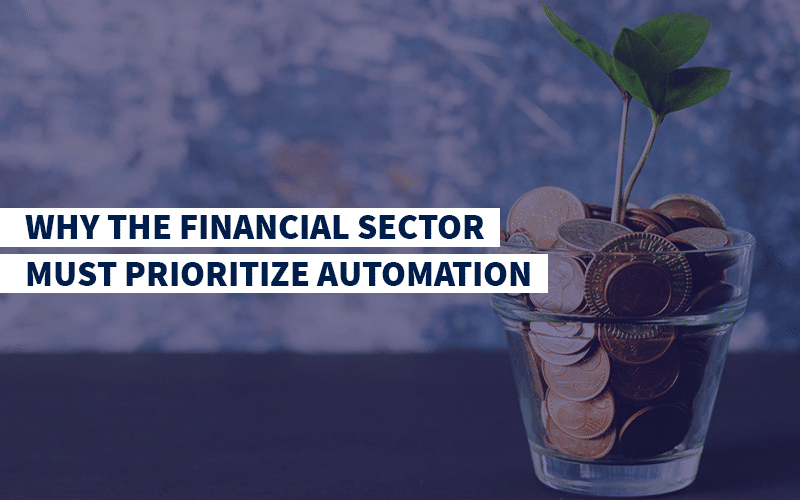
SIRP Provides FREE Risk-Based SOAR Platform for Businesses and MSSPs Hit by COVID-19
April 6, 2020
SIRP Labs Named Leader for Incident Response Software in G2’s Momentum Grid
June 26, 2020
SIRP Provides FREE Risk-Based SOAR Platform for Businesses and MSSPs Hit by COVID-19
April 6, 2020
SIRP Labs Named Leader for Incident Response Software in G2’s Momentum Grid
June 26, 2020Why the Financial Sector
Must Prioritise Automation

The threat of cyber attacks is part and parcel of doing business for organisations of all sizes and in every industry. Every company holds data of some kind that criminals might use for profit, from payroll details to intellectual property – not to mention the company’s own financial accounts.
Companies in the financial sector are especially at risk. Since their principle activity is the management of capital in all its forms, they represent the most direct path to criminals seeking to make some quick money. A recent report from the IMF found that the high volume of sensitive financial information held by banks makes them “one of the most highly targeted economic sectors for data breaches”.
A multitude of threats
The financial sector faces potential cyber threats from every side. APTs (advanced persistent threats) represent the greatest danger. These are used by highly organised groups equipped with the skills and resources to carry out attacks capable of penetrating even the strongest defences. From their perspective compromised banking systems are the holy grail. Over the years the banking sector has repeatedly been the target of cyber security breaches leading to the leaked financial data of millions of customers.
Financial institutions must also contend with threats from within. Malicious insiders, exploiting their knowledge of systems and privileged access rights, can circumvent outward-facing security measures to steal capital or commit insider trading. Financial organisations are no strangers to criminal threats of course – for as long as there have been banks, there have also been bank robbers, fraudsters and criminal chancers of every description.
However, in the digital age these threats have evolved and accelerated at an incredible rate. The advance of technology has transformed the sector in recent years, with most financial services switching to online and mobile platforms. Agile, swift-moving digital native challengers are emerging to snatch up market share from the slower moving traditional firms. While these digitalisation efforts come new opportunities, but they also provide cyber criminals with a greater attack surface to exploit.
Keeping pace in the digital era
While the financial sector has long been familiar with the security and privacy processes needed to combat the threat fraud and theft, they must now adapt to a much more sophisticated adversary equipped with the latest, most advanced hacking tools. To counter this, banks have invested heavily in solutions such as endpoint detection and response (EDR) and behavioural analytics.
Detecting the presence of threats, from insiders to malware infections, however, is only half the battle. It can often take around 45-60 minutes for security analysts to investigate and respond to each threat – each minute that passes carries an increased risk of the attacker escalating and making off with essential data.
The time it takes to investigate a threat is even more unmanageable when you consider the thousands of incident alerts received every day. With far more alerts than they have time to deal with, security analysts are often forced to ignore many of them and prioritise as best they can.
Automation has the answer
Automating as much of the security process as possible massively reduces the burden on overworked security professionals. If each threat takes minutes or even seconds to check this greatly reduces the chance of a crucial threat being overlooked.
That said, automation on its own solves nothing. To be of value it must be able to take account of the organisation’s assets, processes and business goals all at once. From a security perspective this means fusing the different security alerts, threat intelligence feeds, risks and vulnerabilities together with assets to make operations more manageable and context aware.
We recommend organisations begin with those risks that commonly generate large volumes of threat alerts, such as phishing or web-based attacks. Prioritising these cases for automation goes a long way towards relieving the pressure on security resources and freeing-up analysts to spend more time on more complex investigations.
Tools such as Security Orchestration Automation and Response (SOAR) are invaluable for prioritising security responses especially if they can be tied to a risk-based approach that is tailored to a company’s individual infrastructure and business objectives.
The financial sector’s digital transformation journey will always be a target for cyber-highwaymen. The use of automation to increase the speed and efficiency of incident response, however, allows firms to tip the odds back in their favour in their efforts to defend their assets and their customers.
To find out how SIRP can help your security team begin implementing automation to combat advanced threats, get in touch today to arrange your personalised demonstration.

